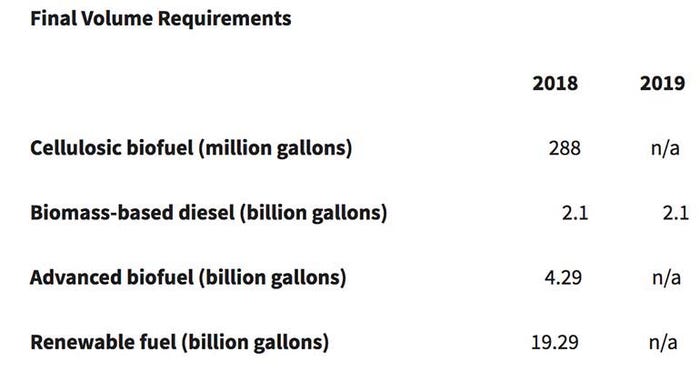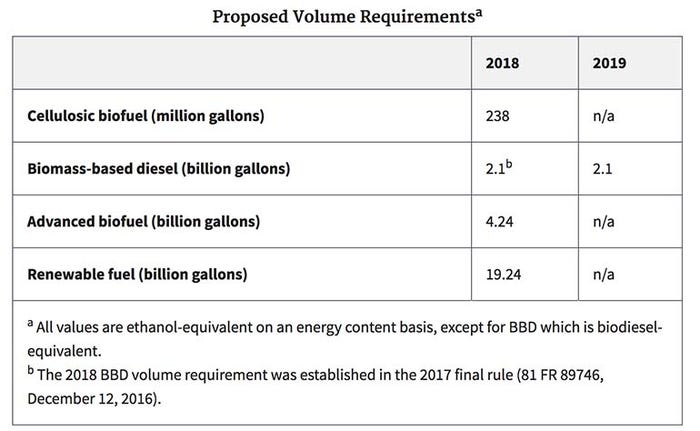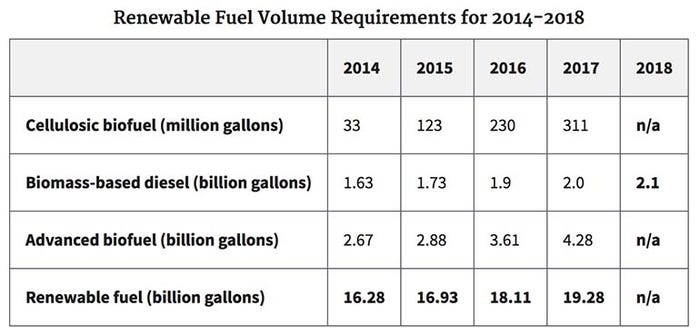
Today’s announcement of the final 2018 Renewable Volume Obligation under the Renewable Fuel Standard is either pleasing or a missed opportunity, depending on your point of view.
The numbers EPA announced Nov. 30 vary only slightly from the proposed standards issued in July.
The final numbers are 19.29 billion gallons of total renewable fuel, which includes 15 billion gallons for conventional biofuel. Advanced biofuel is set for 4.29 billion gallons, including 288 million gallons of cellulosic biofuel. The biomass-based biodiesel amount remains at 2.1 billion gallons.

The proposed numbers were 19.24 billion gallons of total renewable fuel and 2.1 billion gallons for biomass-based biodiesel.

Proposed RFS volume requirements, July 2017.
"Maintaining the renewable fuel standard at current levels ensures stability in the marketplace and follows through with my commitment to meet the statutory deadlines and lead the agency by upholding the rule of law," said EPA Administrator Scott Pruitt.
The National Corn Growers Association said they were pleased with the Trump administration’s commitment “to keep the RFS on track when it comes to conventional ethanol.”
“Not only has EPA hit the mark with the 15 billion-gallon implied target, but EPA has also improved on the proposed rule by correctly growing the total 2018 volume from the 2017 level as intended in the RFS,” said North Dakota farmer Kevin Skunes, president of the National Corn Growers Association, in a media statement.
The American Soybean Association sees things a little differently.
“It’s fair to say that we’re very frustrated yet again by the lack of growth in these volumes by EPA; we can do more, and we’ve shown that year after year,” said American Soybean Association President Ron Moore of Illinois. “The flat nature of the biomass-based diesel and advanced biodiesel volumes continues to be a missed opportunity to capitalize on a valuable market for soybean oil.”

Renewable Fuel Volume Requirements for 2014-2018, December 2016.
What others are saying:
“The EPA’s on-time announcement upholds the statutory targets for conventional biofuels, which will provide much-needed certainty for hard-pressed rural communities,” said Growth Energy CEO Emily Skor.” We would like to have seen a boost to the target blending levels for cellulosic biofuels, and we will continue to work with the administration to advance the RFS goal of further stimulating growth and showing U.S. leadership in 21st century fuels.”
“ACE members are very pleased that the statutory 15-billion-gallon volume for conventional biofuel will be maintained in 2018 and that EPA is increasing the advanced biofuel volume to 4.29 billion gallons. This represents a modest step in the right direction for the RFS in 2018. Beyond sending a generally positive signal to the rural economy, increased blending targets also reassure retailers that it makes sense to offer E15 and flex fuels to their customers,” said Brian Jennings, CEO of the American Coalition for Ethanol. “While the 288 million gallons of cellulosic biofuel EPA is calling for in 2018 is a small increase from the volume proposed earlier this year, it is disappointing the 2018 volume represents a decrease from the 2017 cellulosic biofuel level of 311 million gallons. We firmly believe the technology exists to increase cellulosic biofuel targets.”
“The Trump administration deserves credit for rejecting political pressure to destabilize the RFS, but EPA’s failure to appreciably increase advanced biofuel levels brushes aside a huge opportunity to promote rural jobs and energy innovation,” said Advanced Biofuels Business Council Director Brooke Coleman. “Unwarranted cuts to cellulosic biofuel targets send the wrong signal to global investors in this emerging industry. The cellulosic biofuels industry is growing and stands ready to drive the next great wave of manufacturing jobs across the heartland.”
“We are disappointed that EPA did not significantly raise the advanced biofuel volumes in line with the industry’s ability to produce them,” said Brent Erickson, Executive Vice President of the Biotechnology Innovation Organization’s (BIO) Industrial & Environmental Section. “The agency is arbitrarily limiting growth for low carbon biofuels in 2018 and into the future by looking backward, rather than forward.”
“We feel the administration missed an opportunity in not continuing a sensible and consistent growth trajectory for biomass-based diesel,” said Renewable Energy Group Interim President and CEO Randy Howard. “We firmly believe the U.S. industry is fully capable of delivering increasing volumes of biomass-based diesel to meet a growing RVO as Congress intended when it created the RFS. We will continue to work with EPA in 2018 to develop workable plans for additional growth in 2019.”
What comes next:
“Moving forward, we ask EPA to revisit the growth in cellulosic fuel production, particularly as first-generation ethanol producers expand cellulosic gallons made from feedstocks such as corn kernel fiber,” Skunes said. The NCGA is committed to working with EPA to increase consumer access to renewable fuels.
“We’re disappointed today, as we had originally pushed for a level of 2.5 billion gallons for biomass-based diesel in 2019 and 4.75 billion gallons of total advanced biofuels for 2018, but we’ll continue in our work to develop even greater capacity within our industry, and we urge EPA and the Administration to take another look at biodiesel and the value U.S. soybean farmers bring to the domestic energy discussion,” Moore said.
“America still imports 25% of its oil, and the need for domestic biofuel production is stronger than ever,” said Jeff Broin, POET CEO. “There is enough biomass in the U.S. to eliminate oil imports and give our nation true energy independence. By using starch and cellulosic feedstocks, we can grow US biofuel production and help stabilize farm incomes at a time when rural America needs it most. We will work with the administration and EPA going forward to restore growing biofuel targets that will spur innovation in rural communities.”
About the Author(s)
You May Also Like




